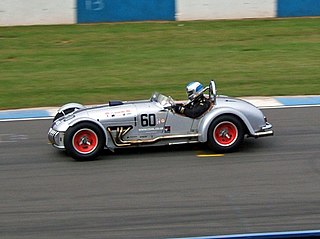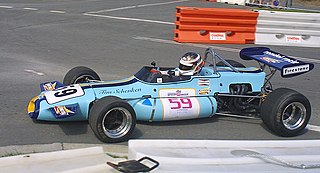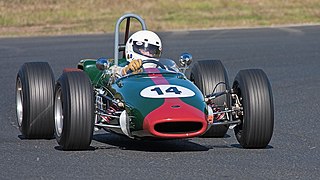Related Research Articles
Brabham is the common name for Motor Racing Developments Ltd., a British racing car manufacturer and Formula One racing team. Founded in 1960 by Australian driver Jack Brabham and British-Australian designer Ron Tauranac, the team won four Drivers' and two Constructors' World Championships in its 30-year Formula One history. Jack Brabham's 1966 FIA Drivers' Championship remains the only such achievement using a car bearing the driver's own name.

Rick Ravon Mears is a retired American race car driver. He is one of four men to win the Indianapolis 500 four times and is the current record-holder for pole positions in the race with six. Mears is also a three-time Indycar series/World Series champion.

John Sherman "Johnny" Rutherford III, also known as "Lone Star JR", is an American former automobile racing driver. During an Indy Car career that spanned more than three decades, he scored 27 wins and 23 pole positions in 314 starts. He became one of ten drivers to win the Indianapolis 500 at least three times, winning in 1974, 1976, and 1980. He also won the CART championship in 1980.

Kurtis Kraft was an American designer and builder of race cars. The company built midget cars, quartermidgets, sports cars, sprint cars, Bonneville cars, and USAC Championship cars. It was founded by Frank Kurtis when he built his own midget car chassis in the late 1930s.
Edward Julius Sachs Jr, was a United States Auto Club driver who was known as the "Clown Prince of Auto Racing". He coined the phrase "If you can't win, be spectacular".
Chaparral Cars was a pioneering American automobile racing team and race car developer that engineered, built, and raced cars from 1963 through 1970. Founded in 1962 by American Formula One racers Hap Sharp and Jim Hall, it was named after the roadrunner, a fast-running ground cuckoo also known as a chaparral bird.

Joe Leonard was an American professional motorcycle racer and racecar driver.

The 1980 CART PPG Indy Car World Series season was the second in the CART era of U.S. open-wheel racing. It consisted of twelve races, beginning in Ontario, California on April 13 and concluding in Avondale, Arizona on November 8. The PPG Indy Car World Series Drivers' Champion and Indianapolis 500 winner was Johnny Rutherford. Rookie of the Year was Dennis Firestone. The entire season, including the 64th Indianapolis 500, was to be co-sanctioned by both the USAC and CART under the banner of the Championship Racing League (CRL). However, USAC withdrew from the arrangement after five races.

The Brabham BT36 was an open-wheel Formula 2 race car, designed by Ron Tauranac, and developed and built by British racing team and constructor, Brabham, for the 1971 European Formula Two Championship. Its best result that season was a 2nd-place finish in the championship for Argentine Carlos Reutemann, despite only winning one race, taking one pole position. His consistency and pace made up for this, scoring 6 podium finishes, and finishing the season with 40 points. The Brabham BT36 was constructed out of a complex tubular space frame, and was powered by the naturally-aspirated 1.6 L (98 cu in) Ford-FVA Cosworth four-cylinder engine, which produced 220 hp (160 kW), and drove the rear wheels through a 5-speed Hewland F.T.200 manual transmission.

The Brabham BT18 was an open-wheel formula racing, designed, developed, and built by British constructor Brabham, for both Formula 2 and Formula 3 racing categories. Powered by a Honda engine, it won 11 out of 12 races in 1966.

The Brabham BT14 was an open-wheel mid-engined formula racing car, designed, developed and built by British manufacturer and constructor Brabham, in 1965. A total of 10 models were produced. It was specifically constructed to compete in Formula Libre racing. It competed in motor racing between 1965 and 1968; winning a total of 10 races, scoring 22 podium finishes, and clinching 4 pole positions. It also contested the 1967 European F2 Championship season, competitng in 7 races, but with no success; scoring no wins, pole positions, podium finishes, or scoring any points. It was powered by a naturally-aspirated 1.6 L (98 cu in) Ford twin-cam four-cylinder engine, which droves the rear wheels through a conventional 4-speed manual transmission.
Alex Morales Motorsports was a racing team active in sprint cars and Indycars for several decades. The sprint car team won multiple championships between the 1950s and 1990s while their Indycar team was active from 1975 to 1989, winning three races. The team was owned by California businessman Alex Morales who sponsored the team with his Alex Foods brand in the earlier years and was managed by chief mechanic John Capels, who later served on CART’s board of directors.

The McLaren M16 was a race car designed and built by McLaren between 1971 and 1976 for American open wheel racing. It is the most successful car of the 1970s at the Indianapolis 500 with three wins in 1972, 1974 and 1976 and the last one to win with the Offenhauser engine.
The Parnelli VPJ6 is an open-wheel race car, designed by British designer John Barnard for Vel's Parnelli Jones Racing, to compete in U.S.A.C. Championship Car, between 1975 and 1980, as well as in CART, between 1979 and 1980. It was driven by Danny Ongais, Al Unser, George Snider, Bill Whittington, Lee Kunzman, and A. J. Foyt. It notably gave Foyt his last IndyCar championship, in 1979. It was powered by the powerful and successful DFV-derived DFX.

The Brabham BT30 was an open-wheel Formula 2 racing car used in the 1969, 1970, and 1971 European Formula Two Championship.

The Brabham BT25 was an open-wheel racing car used in the 1968 and 1969 USAC Championships.

The Brabham BT12 was a mid-engined open-wheel racing car, designed, developed and built by the Brabham team, to compete in the 1964 Indianapolis 500. Jack Brabham managed to qualify the car on the grid in 25th-place, but retired on lap 77 of the race due to a fuel tank damage, from a collision on the first lap. The car was powered by an naturally aspirated Offenhauser 252 cu in (4.13 L) DOHC inline four-cylinder engine, making about 420 hp (310 kW).
The Lola T270 is an open-wheel racing car chassis, designed, developed and built by Lola Cars, that competed in the CART open-wheel racing series, for competition in the 1972 and 1973 USAC Championship Car seasons. It didn't win any races, with its best race result being a 2nd-place finish; being driven by Wally Dallenbach at Michigan in 1972. Its best Indianapolis 500 result was a 4th-place finish; being driven by Sam Sessions, in the 1972 race. It was powered by three different engines; including Ford and Foyt-badged Ford V8 turbo engines, or an Offenhauser four-cylinder turbo engine.
The Lola T80 was an open-wheel race car, developed and built by British manufacturer Lola, and designed by Eric Broadley, in 1965. Its best race result and position was a 4th-place finish, at Trenton in 1965; being driven by American Bud Tingelstad. Its best result at the Indianapolis 500 was a 9th-place finish, with Al Unser driving at the 1965 race. It was powered by the Ford quad-cam DOHC Indy V8 engine, developing around 425 hp (317 kW) @ 8,000 rpm. It was used alongside, and eventually succeeded, by the T90.

The Brabham BT17 was a one-off sports prototype race car, designed by British-Australian engineer Ron Tauranac, and developed and built by British manufacturer, constructor, and Formula One racing team, Brabham. It was built to Group 7 racing specifications, in 1966, and was the only Group 7 sports car built by Brabham. Only one single model was produced. It only contested three sports car races, scoring no wins, podiums, pole positions, or points finishes.
References
- ↑ Brown, Allen. "Brabham BT32 history". OldRacingCars.com.
- ↑ "Brabham BT32 Offy – primotipo…". primotipo...
- ↑ World, Auto Sport. "Find out all the information about the race car Brabham BT32. As well as its drivers and results". Auto Sport World.
- ↑ "OFFENHAUSER: The Engine That Became a Racing Legend" . Retrieved 15 June 2022.
- ↑ Kimbrough, Bobby (December 24, 2012). "Offenhauser. The Greatest Racing Engine Ever Built?". Street Muscle.
- ↑ Zurschmeide, Jeff (March 16, 2017). "The Immortal Offenhauser Racing Engine". EngineLabs.